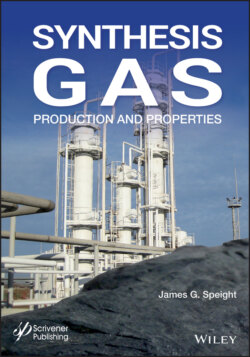Читать книгу Synthesis Gas - James Speight G., James G. Speight - Страница 46
2.5.3 Char Gasification
ОглавлениеThe gasification process occurs as the char reacts with gases such as carbon dioxide and steam to produce carbon monoxide and hydrogen. Also, corrosive ash elements such as chloride and potassium may be refined out by the gasification process, allowing the high temperature combustion of the gas from otherwise problematic feedstocks. Although the initial gasification stage is completed in seconds or even less at elevated temperature, the subsequent gasification of the char produced at the initial gasification stage is much slower, requiring minutes or hours to obtain significant conversion under practical conditions and reactor designs for commercial gasifiers are largely dependent on the reactivity of the char, which in turn depends on the nature of feedstock. The reactivity of char also depends upon parameters of the thermal process required to produce the char from the original feedstock. The rate of gasification of the char decreases as the process temperature increases due to the decrease in active surface area of char. Therefore a change of char preparation temperature may change the chemical nature of char, which in turn may change the gasification. The reactivity of char may be influenced by catalytic effect of mineral matter in the char.
Heat and mass transfer processes in fixed- or moving-bed gasifiers are affected by complex solids flow and chemical reactions. Moving-bed gasifiers are countercurrent flow reactors in which the feedstock enters at the top of the reactor and oxygen (air) enters at the bottom of the reactor. Because of the countercurrent flow arrangement of the reactor, the heat of reaction from the gasification reactions serves to pre-heat the coal before it enters the gasification reaction zone. Consequently, the temperature of the synthesis gas exiting the gasifier is significantly lower than the temperature needed for complete conversion of the feedstock. However, coarsely crushed feedstock may settle while undergoing (i) thermal drying, (ii) pyrolysis-devolatilization, (iii) gasification, and (iv) reduction. In addition, the particles change in diameter, shape, and porosity – non-ideal behavior may result from bridges, gas bubbles, channeling, and a variable void fraction may also change heat and mass transfer characteristics.
